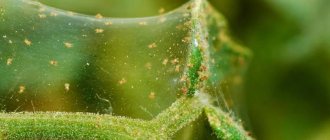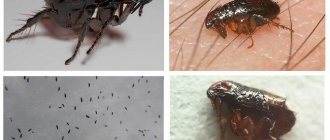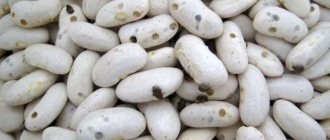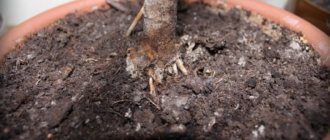Author: Elena N. https://floristics.info/ru/index.php?option=com_contact&view=contact&id=19 Category: Plant Pests Published: August 01, 2017Last edits: October 28, 2020
- Spider mites on roses
- Spider mites on currants
- Spider mites on seedlings
- Spider mites on an orchid
Spider mites (lat. Tetranychidae) are a family of arachnid arthropods of the order Thrombidiformes, representatives of which are found throughout the world. In nature, there are 95 genera and more than 1270 species of spider mites. The most famous member of the family is the common spider mite.
Description
Spider mites reproduce very quickly and instantly move from one plant to another. Pests feed on the contents of plant cells. The presence of mites can be detected by the appearance of small white dots on the leaves of the plant on the underside of the plate and by the thinnest cobwebs. As a result of the activity of spider mites, some of the plant cells are destroyed, and the intensity of photosynthesis decreases.
With severe damage, the leaves turn white from multiple damages, the plant is enveloped in cobwebs, and a mass of mites accumulates on the tips of the leaves and shoots.
In addition, the mite can infect the plant with incurable viral infections and gray rot spores.
- Leaf roller: how to fight, remedies and preparations
At home, in the garden and garden, plants are damaged by several types of spider mites:
- common (lat. Tetranychus urticae): the length of female common spider mites can be from 0.4 to 0.6 mm, males are usually shorter - from 0.3 to 0.45 mm. At the larval stage of development, mites are transparent, painted in different colors: from pale green to greenish-brown. Large dark spots are clearly visible on the sides - the blind sacs of the midgut. Tick larvae have 6 legs, and adults have 8 translucent legs with prehensile claws. Spider mites live everywhere except Antarctica. The life cycle of the common tick consists of several stages: egg, larva, nymph and adult, colored red-brown and orange (females), as well as greenish or yellowish (males). The common spider mite is a polyphagous, that is, a polyphagous arthropod;
- red (lat. Tetranychus cinnabarinus). This pest damages agricultural and ornamental plants. In warm regions it lives in open ground, and in northern regions it lives only indoors;
- Atlantic (lat. Tetranychus atlanticus) – a ubiquitous species of mite that damages cucumbers;
- Turkestan (lat. Tetranychus turkestani) is a polyphagous plant that feeds on both garden plants (tomatoes, peppers, cucumbers) and ornamental plants.
Common pests from this family also include red-legged and Savzdarga ticks. However, despite such a variety of pest species, measures to combat spider mites are almost the same.
Prevention
To prevent tick infestation in your home:
- Each new plant purchased must be quarantined for 2 weeks. After this, making sure that there are no parasites on it, the plant is placed next to the others.
- All purchased soil, like any street soil, must be disinfected before use. The easiest way: bake in the oven at 90 degrees for half an hour.
- Since ticks do not like high humidity, the moisture level must be constantly maintained. To do this, you can regularly spray the plants in your apartment with a spray bottle.
- You also need to constantly maintain cleanliness, do not accumulate dust on the windowsills or on the leaves of plants.
To prevent mite infection in a greenhouse or in open ground, you can plant dill next to the seedlings. It will attract beneficial insects and repel spider mites with its aroma.
Fighting ticks is not so easy; it is much easier to arrange preventive measures and treatment with drugs. But even in fairly advanced cases, using the full range of remedies in a timely manner, you can save and cure at least the remainder of the harvest in the garden and garden, as well as your favorite flowers in the apartment.
Preventative treatment
The main reason for the appearance of spider mites on plants is dry air, so the best preventive measure is spraying plants in dry weather. However, you need to ensure that water does not remain in the grooves and core of the plants for a long time.
You need to be especially careful in winter, because under conditions of short daylight hours and low temperatures, at which indoor plants remain dormant, water evaporates more slowly. There is no point in immersing the entire plant in water to get rid of pests: when mites come into contact with water, they are protected by air bubbles covering them.
To protect against spider mites, spraying indoor plants with undiluted medical alcohol is sometimes used, but care must be taken when doing this.
In dry weather, both indoor and garden plants should be sprayed with water. However, this procedure is only effective as a preventive measure, but if spider mites have already settled on the plants, completely different measures must be taken.
Stages of tick development
- Egg. The rate of embryo development depends on the ambient temperature. The higher it is, the faster hatching will occur.
- Larva. After birth, she immediately begins to feed on plant juice. Unlike the adult, which has 8 legs, the larva has 6 limbs. Development occurs within 1 – 3 weeks.
- Nymph. This is a grown larva, but not yet an adult, already having 4 pairs of limbs.
- Adult (imago), pictured.
Fighting with folk remedies
To combat spider mites, there is a wide selection of folk remedies - decoctions and infusions of plants that have insecticidal properties and are used for spraying. For example:
- 1 kg of finely chopped dry leaves and stems of black henbane, pour 10 liters of water, leave for 12 hours, strain and add 20-40 g of liquid soap;
- 1 kg of dry or 2.5-3 kg of fresh henbane grass, collected during the flowering period, add a small amount of water and boil in an enamel bowl for 2-3 hours, then cool, strain and add water to a volume of 10 liters;
- Pour 200-400 g of crushed roots or 500 g of fresh leaves of dandelion into a bucket of warm water (about 40 ºC), leave for 2-3 hours, strain and use immediately: the first time when the leaves bloom, the second time after flowering, the third time after 10-14 days;
- 1 kg of crushed dry or 2 kg of fresh gray alder leaves is poured with water and left for 24 hours, then boiled for half an hour and filtered after half a day;
- 1 kg of crushed dry or 3 kg of fresh chamomile, pour 10 liters of water at a temperature of 60-70 ºC, leave for 12 hours, strain, dilute with water 2-3 times and add 10 to 40 g of liquid soap;
- Infuse 400 g of dry tobacco or shag in 10 liters of water for a day, then boil for 2 hours, cool, strain, add water to a volume of 10 liters and add 50 g of soap;
- Chop 500 g of garlic, add 3 liters of water, leave for 5 days in a warm, dark place and strain. To treat plants against ticks, 60 g of infusion is diluted in 10 liters of water and 50 g of soap is added;
- 1200 g of fresh or 800 g of dried green potato tops are poured into 10 liters of warm water, left for 3-4 hours and filtered;
- 200 g of onion peels are poured into 10 liters of warm water, left for 4-5 days, filtered and treated with plants three times every 5 days;
- 4 kg of chopped tomato tops are poured into 10 liters of water, boiled over low heat for half an hour and filtered. Add 2-3 liters of tops decoction and 40 g of soap to 10 liters of water.
Treatment of plants with decoctions and infusions is carried out in the evening as a preventive measure or when there is a small number of mites. Try to alternate folk remedies for treating spider mites. Soap, washing powder (4-5 g per 1 liter of water) or liquid detergent are added to the decoction or infusion immediately before the procedure. It is better not to use folk remedies from poisonous plants at home. Keep in mind that plant poisons are just as unsafe for humans as chemicals, so when preparing them, try not to exceed the dosage.
Advantages and disadvantages of using traditional methods
Advantages:
- Folk remedies do not pollute the environment, they are harmless to humans, animals and beneficial insects;
- They have a low cost or are free;
- Can be used both for spraying and watering plants;
- Some remedies have not only healing, but also stimulating properties.
Flaws:
- Ineffective in killing insect eggs;
- Some medications can take a long time to prepare.
Remedies and preparations for spider mites
Since mites, spiders and scorpions are not insects, insecticides are useless against spider mites. Effective drugs against arthropod pests are acaricides (Sunmite, Demitan, Omite, Flumite, Floromite, Nissoran, Bicol, Bitoxibacillin, Envidor, Apollo, Borneo) or insectoacaricides (Akarin, Agravertin, Vertimek, Dursban, Karate, Kleschevit, Fitoverm, Aktofit, Neoron , Talstar, Fufanon, Oberon). All these drugs are used in strict accordance with the instructions.
Plants are treated with chemical protection against ticks several times to ensure that the most persistent individuals and their eggs are destroyed. At a temperature of 20 ºC, at least three treatments must be carried out with an interval of 10 days, and at a temperature of about 30 ºC, 3-4 treatments are necessary every 3-4 days, otherwise the females that emerge from the eggs will have time to lay new eggs.
Unfortunately, among the listed drugs there are no ones that would be absolutely safe for humans, so it is better to prevent the appearance of pests. Make it a rule to regularly inspect your plants and carry out preventive spraying.
Ways to eliminate the pest
Most popular insecticides designed to combat a variety of insects are not effective against spider mites. This parasite must be eliminated using special acaricidal or insectoacaricidal agents. Such drugs can have a systemic, contact or intestinal effect on the pest organism.
It should also be borne in mind that most acaricides do not have an ovicidal effect, so it may be necessary to re-spray the plants after 5-6 days. Primary treatment usually results in the elimination of active, adult individuals. Then, within 5-7 days, the surviving larvae and nymphs will become sexually mature and it will be their turn during re-treatment.
Experienced gardeners and gardeners recommend alternating means to combat such insects, changing the active substance, since spider mites easily adapt to the chemicals used. In our review, we have collected the best acaricidal, insectoacaricidal, and biological products to combat these arachnids.
How to deal with spider mites in the garden
Spider mites on cucumbers
The presence of spider mites on cucumbers can be determined by white puncture spots and light, thin webs. With severe damage, the leaves turn white completely. Pests accumulate on the leaves and shoots of the plant. How to treat cucumbers against spider mites? You can start fighting the pest by spraying with warm water with laundry soap dissolved in it, but before that, severely damaged leaves must be removed from the cucumbers and burned, preventing the proliferation and spread of spider mites to other plants. It is better to completely destroy cucumber bushes that are infested with ticks.
Growing cucumbers in open ground - planting and care
To create conditions unbearable for mites, on a cloudy day, water the garden bed generously, then immediately cover it with film: under the cover, the air humidity will become very high, and this will greatly harm spider mites.
- 5 most dangerous potato pests
If the damage is significant, the cucumbers will have to be treated with acaricides. However, the appearance of ticks in a bed of cucumbers can be prevented if you change the area for the crop every year, plant the bushes according to a scheme developed by specialists, without thickening the planting, and in the fall, remove all plant debris from the bed and dig up the soil.
Spider mite on pepper
Peppers are mainly parasitized by tetranych mites. From their punctures, a characteristic marbling is formed on the leaves. Spider mites settle on pepper seedlings and adult plants. Over time, the puncture points merge, and the affected leaves turn brown. As mites move through the plant, they leave webs on the leaves and stems. Heavily webbed plants dry out because their photosynthesis and transpiration rates are reduced. The loss of pepper yield due to severe spider mite infestation can reach 60%. As with other plants, favorable conditions for spider mites to appear on peppers include dry air, dehydration of plant tissues, and too high levels of nitrogen in the soil.
Growing peppers - planting and care in open ground
The fight against spider mites on peppers is carried out in all possible ways: removing the affected leaves, and sometimes the entire plant, spraying with water, insecticidal infusions and decoctions in the evenings, and also, in case of severe occupation, treating the pepper with chemicals. Among the folk remedies, washing plants with a soap solution (a bar of laundry soap per 10 liters of water), spraying with 96% alcohol, a decoction of black henbane, tobacco or an infusion of garlic are effective. Of the acaricides, the most effective are Kleschevit, Apollo, Akarin, Actellik and Dicofol 20%.
Spider mites on eggplants
A spider mite that has settled on eggplants can cause colossal losses, since it can destroy the entire crop in two weeks. And if you do not take measures to destroy it, then, after overwintering in the soil, the pest in the spring will take up the destruction of next year’s crop with renewed vigor.
Growing eggplants in open ground - planting and care
As soon as you notice discolored spots on your eggplant leaves, start dealing with mites immediately. By what means to do this is up to you. If there are few ticks, you can start with folk remedies that are less toxic to humans or use a biological method: introduce predatory Amblyseius or Phytoseiulus mites, which can be purchased at garden centers, into the garden bed. But if there are a lot of pests, do not waste time and immediately start treating eggplants with acaricides.
Spider mites on tomatoes
Having appeared on tomatoes, spider mites bite through the leaf plates, as a result of which they turn yellow and dry out. As a preventative measure, it is necessary to regularly weed the beds and remove damaged leaves and shoots from the bushes. The fight against pests on tomatoes begins with the use of folk remedies, and it is necessary to resort to acaricides only if treating tomatoes with decoctions and infusions does not produce results.
Tomatoes in open ground - planting and care
What folk remedies help get rid of mites on tomatoes? Soap solution (1:6), two percent bleach solution, medical alcohol, black henbane infusion. Of the chemical preparations, it is better to use Plant-Pin, Fitoverm, Actellik, Etisso, Apollo, Aktaru, Antiklesch or Fufanon.
Plan for treating plants with drugs
The plant treatment scheme is directly linked to the biological development cycle of the spider mite.
- The first spraying is aimed at destroying the bulk of adult individuals. Regardless of the drugs used, the majority of pests (70-80%) will be destroyed.
- The second should be carried out a week later, when new individuals hatch from the eggs.
- A third spraying is carried out again a week later for final destruction.
- Many experienced indoor crop lovers add a fourth spraying to eliminate possible remnants of the population.
Fighting spider mites on flowers
Spider mites on roses
Spider mites on flowers are as common as on vegetables, but of all garden flowers, roses attract the pest the most. Plants that are depleted by improper care primarily fall victim to spider mites: white dots appear on the leaves of roses, and when severely infested, whitish spots appear. Then the leaves turn yellow and fall off, cobwebs appear, and upon closer examination, small moving dots—spider mites—can be seen on the underside of the leaves.
Growing roses - planting and caring for the garden
Since the best fight against diseases and pests is prevention, do not forget to water your roses and carefully inspect the back of the leaves as often as possible, and at the first sign of pests, begin to destroy them. If you miss the moment, then by autumn the number of fertile ticks can increase hundreds of times. Even the arrival of winter will not solve the problem: the mites will safely overwinter in the soil or under leaves and in the spring they will again begin their destructive activities. Therefore, ticks must be destroyed immediately and for sure, using acaricides Neoron, Fitoverm, Actellik and the like. When preparing solutions for treating roses, strictly follow the instructions, since acaricides contain substances that are dangerous to humans and domestic animals.
Symptoms of plant damage
The following signs of mite damage to plants are distinguished:
- Brown spots that look like holes made with a needle.
- Yellow or light green dots.
- Falling flowers and leaves.
- Slow plant growth.
- Silvery webs between the leaves.
- The presence of small insects on the underside of foliage that look like red or yellow moving dots.
- A large number of mites on the web is a sign of a large mite infestation.
- The presence of black grains that are easily separated from the plant - mite excrement.
The spider parasite loves greenhouse crops with thick, fleshy leaves. Plants such as ficus, hibiscus, and fuchsia are most susceptible to its attacks.
Fighting spider mites in the orchard
Spider mites on currants
A spider mite that appears on the leaves of black, red or white currants can threaten the complete loss of the berry harvest. If the berries have already set before the mites appear, they are in no danger: the mites will harm the leaves, but will not significantly affect the quantity and quality of the harvest, so you can fight them using folk remedies. Infusions and decoctions of insecticidal plants will do a great job with a small number of spider mites. But if there are a lot of pests and if they appeared before flowering or before the ovary ended, then the ripening of the berries may be at risk.
Growing currants - planting and care in the garden
If you find mites on currants before flowering, feel free to use acaricides to kill the pests. Keep in mind that white and red currants are more vulnerable than black currants. So:
- first remove from the bush and burn absolutely all the leaves damaged by the mite, then water the bushes abundantly, washing away the remaining insects with a strong stream;
- be sure to remove cobwebs, otherwise they will turn into a water-repellent barrier;
- a good result is obtained by spraying the bush with water, if immediately after this you briefly wrap the plant with a film, creating an eighty percent air humidity under it that is unbearable for ticks;
- Place jars of turpentine or ammonia around the bush and cover the bush with film: turpentine and ammonia will quickly kill ticks;
- folk remedies will almost certainly cope with a small number of pests, but if the bush is severely affected, then, without wasting time, start treating the currants with acaricides.
If you notice spider mites on gooseberries, use the same means to control them as you would to control pests on currants, since the two crops are closely related.
Spider mites on grapes
In addition to common spider mites, grapes are damaged by red fruit mites and sometimes hornbeam spider mites. Newly hatched red fruit mite larvae can be seen on the underside of young grape leaves in early spring. The common spider mite first develops on weeds and appears later on grapes. But these types of mites harm grapes in the same way: with their pointed lower jaw they penetrate the cells and absorb their contents, releasing their poisonous saliva into the leaf tissue.
How to grow grapes - planting and care
When grapes are early affected by mites, their leaves practically do not grow and are deformed, often curling, acquiring a light brown color and falling off prematurely. The degree of damage is influenced by the grape variety, nutrition, location of the bush and weather conditions.
- Rodents: how to get rid of them and why they are dangerous
Before the buds open, it makes sense to treat mite-affected grapes with Nitrophen or DNOC, after removing diseased leaves and severely damaged bark. After the start of growth, the plants are treated with Neoron, Fozalon, Akrex, Pliktran, Keltan or Rogor. If the drug has a short period of action, you need to repeat the treatment after 10-12 days. You should know that spider mites are capable of developing resistance to drugs, so when processing, alternate acaricides with different active ingredients.
Spider mites on strawberries
The most dangerous parasites are strawberry mites, especially since they are very difficult to notice. As a result of the activity of mites, the entire berry crop can be destroyed, and at the same time there remains a possibility that, due to mites disrupting the growth of flower buds, problems with the harvest may arise next year. Gardeners have identified the following pattern: the older the strawberry bed, the more damage the pest can cause to it. Ticks are most dangerous for bushes that are 3-4 years old.
Growing strawberries - planting and caring for them
Infection of strawberries with spider mites occurs through seedlings. Pests can enter the area from people's shoes and clothes. Peak population growth occurs in August and September. You can detect mites on strawberries by the following signs:
- the bushes do not develop, small wrinkled leaves with abnormally curly edges appear on them;
- a silvery film forms on the underside of the leaves;
- leaves acquire a yellowish tint;
- the berries do not develop and dry out;
- In winter, the plantation freezes.
When starting to fight mites on strawberries, you should know that they concentrate in places that are difficult to treat, so it will not be possible to completely destroy them. But in order to curb the development of the population and save the harvest, it is necessary to fight spider mites. The best way to destroy the pest is to release predator mites into the area. Biological enemies of ticks can greatly reduce their numbers. After harvesting, you can cover the bushes with plastic film, preventing air from getting under it. When the temperature under the film rises to 60 ºC, remove it and cut off the affected bushes at the root, then cover the bed with humus. You can also use folk remedies, for example, spraying with onion or garlic infusion: once at the very beginning of the growing season and twice after harvesting, each time after treatment, covering the strawberries with film for several hours.
Spider mite on an apple tree
If there is a strong invasion of spider mites, the apple tree may lose up to half of its leaves by mid-summer. As a result, its productivity is significantly reduced. Therefore, as soon as you notice the presence of pests on the tree, begin to decisively combat them. Of the folk remedies, the most effective is tobacco solution, which is used to treat the apple tree twice at intervals of a week. In advanced cases, you will have to spray the apple tree with Nitrophen or Decis twice: after the ovaries appear and a month before harvest. In the fall, you need to remove all fallen leaves and fruits from under the tree, cut out old and diseased branches in which ticks can overwinter, and burn all these plant debris.
Growing apple trees in the garden - planting and care
What plants does the pest attack?
Among vegetables, spider mites often attack cucumbers, tomatoes, eggplants, peppers, legumes, and pumpkin crops .
Strawberries, gooseberries, currants, raspberries, and grapes are damaged by insects .
Spider mites harm fruit trees: apple trees, pears, apricots, cherries, plums, cherry plums .
The parasite loves flowers and ornamental plants: roses, asters, palm trees, fuchsias, callas, citrus fruits, orchids, impatiens, abutilons, ficuses, saintpaulias, cyclamen, pelargoniums, azaleas .
Spider mites in greenhouses
Spider mites on seedlings
Spider mites in a greenhouse with cucumbers and other plants can produce up to 20 generations of pests in one year. Spider mites enter the greenhouse and spread throughout it in search of the best conditions and the most suitable crop. Most often, their victims are cucumbers, tomatoes, peppers and eggplants, even in the seedling stage. Along the main leaf vein of the leaves, tiny, pinprick-like, yellowish dots appear, which become colorless over time, and then a thin web appears, along which mites can easily move. Pests concentrate in the upper part of the plant, sucking cell sap from the leaves, settling on their underside.
To reduce the risk of spider mites appearing on seedlings in a greenhouse, you should alternate seedlings when planting: cucumber seedlings with tomatoes, cabbage or leafy vegetables. Inspect the seedlings as often as possible, and as soon as you find mites, remove and burn the damaged leaves, and in case of significant damage, treat the seedlings with Bitoxibacillin, Fitoverm or colloidal sulfur, and if these drugs do not help, use a solution of a broad-spectrum acaricide - Actellica, for example. The sooner you take action, the greater your chances of saving the seedlings.
Spider mites on mature plants
It is impossible to expel spider mites from a greenhouse with ultraviolet rays, infusions and decoctions of plants, or spraying with water. To save the crop, you will have to use acaricides, treating the plants with their solutions every two weeks until the pest is completely defeated. If there are a small number of spider mites in the greenhouse, you can try to cope with them with the help of their biological enemies - predator mites. There will be no harm to vegetable plants from phytoseiulus: as soon as there are no spider mites left in the greenhouse, it will die of starvation. If you have to use acaricides, strictly follow the manufacturer’s instructions and safety rules for working with toxic drugs in enclosed spaces.
As a preventive measure, at the beginning of winter it is advisable to fumigate the greenhouse with sulfur in order to destroy ticks that have gathered to spend the winter in the greenhouse. Instead of sulfur, you can spray the greenhouse with a solution of slaked lime, and heat the supporting metal risers with a gas burner. During the period of planting vegetables, maintain high air humidity in the greenhouse through timely watering and frequent spraying of plants with water. Weekly two-minute treatment of the greenhouse with ultraviolet rays increases resistance to pests and diseases.
Resistant varieties of eggplants and cucumbers
Today, breeders from all over the world are working to create new varieties of vegetables, including pest-resistant ones.
Most eggplant varieties and hybrids are not resistant to spider mites.
Samurai Sword
Caliph
But there are several resistant species: these are the eggplant varieties “Samurai Sword” and “Caliph”.
When growing cucumbers, you also need to choose strong, resistant varieties.
Hybrid “Rodnichok” The popular hybrid “Rodnichok” is getting better every year, it can compete with European varieties. The fruits need sufficient moisture, however, this plant has good immunity against diseases and pests.
Variety “Murashka F1” The early ripening variety “Murashka F1” has also earned good reviews; it not only produces an excellent harvest in the greenhouse and open ground, but is also less likely to be affected by spider mites. The fruits have an improved taste and are suitable for pickling and fresh consumption.
Variety “Murashka F1”
Hybrid "Benefit F1" Among the early ripening varieties, it is also recommended to choose the hybrid "Benefit F1", subject to careful care and watering, it avoids damage by spider mites.
Spider mites on indoor plants
Spider mites on an orchid
To protect orchids from spider mites, you need to create conditions for them that are as close to natural as possible. And even if you succeed, you need to constantly monitor the condition of the flowers, because the sooner you can detect pests, the easier and faster you will get rid of them. Optimal living conditions for ticks are air humidity of 30-40% at a temperature of about 27 ºC.
The red mite most often settles on the orchid, which is called false mite because it does not weave a web. This makes it more difficult to detect. He can enter the room with a new plant or a bouquet of flowers. After a tick bites, a silvery sheen appears on the orchid leaf, then the leaf turns yellow and falls off. You can find out whether there are mites on an orchid by placing a piece of apple on the substrate: after a while, all the pests will gather on it.
Each new flower must be inspected before being brought home. To prevent the spread of mites, wash your orchids regularly in a (relatively) hot shower. Orchids with tough leaves, such as cattleyas, can be wiped with a cotton swab dipped in rubbing alcohol, but test the alcohol on a small area of an old leaf first.
Since folk remedies are not always effective, and you don’t have to eat orchids, it makes sense to treat mite-infested plants with acaricides without wasting time.
Spider mite on lemon
You can determine that your indoor lemon has spider mites by the appearance of yellow dots on its leaves and yellowing of their tips. If you put a white leaf in a pot and shake the plant, and then look at the leaf under a magnifying glass, you can see mites. At a later stage, a thin web may appear on the lemon. The mite poses a danger to the lemon tree not only in itself, but also as a carrier of viral diseases, for which, alas, no cure has yet been invented. That is why, at the first sign of the presence of spider mites, you need to take immediate action.
Lemon care at home
After protecting the soil in the pot with a plastic bag, wash the crown of the tree with soapy fifty-degree water. As a result of the water procedure, there will be significantly fewer ticks on the lemon. You can protect lemon and other indoor plants from spider mites by placing a pot of geraniums nearby to repel these pests. Rosemary oil, the aroma of which pests cannot tolerate, helps protect lemons from ticks: dilute a few drops of oil in warm water and spray the lemon. Frequent but short-term exposure to ultraviolet rays repels ticks and strengthens plant immunity. To do this, you need to turn on the lamp for a couple of minutes every day.
But if, as a result of all these attempts, you have not been able to get rid of mites completely, treat the plant with an acaricidal preparation: Fitoverm, Actellik or Demitan. The last drug, which has an action period of 45-60 days, is especially effective against ticks on lemon. However, Demitan is toxic to fish, so you need to treat lemon as far as possible from the room with the aquarium. In addition, the drug is addictive and can only be used once. For subsequent treatments, which are carried out several times every 7-10 days, you will have to purchase other acaricides.
Causes of the parasite
How and where does the parasite get to the plant? There may be the following reasons for this:
- With an infected plant brought from a nursery or store.
Important! When purchasing a new flower, you should immediately examine your pet thoroughly. If there are white or yellow spots on the leaves, you should refuse to purchase.
Advice! Immediately place the new plant for 2 weeks in a separate place, away from other plants. If problems suddenly arise with mites or other insects, other plantings will not be affected.
- With purchased or street soil substrate, humus. Under unfavorable conditions, an insect can hibernate and not reveal itself in any way. At high temperatures and low humidity, the tick wakes up and becomes more active.
Advice! Before using such soil, it must be disinfected using hot temperatures, for example, calcination.
- With the wind, which carries ticks through the air. On an open balcony, the likelihood of picking up a parasite increases.
- With gardeners' clothes. Clinging to a shirt or trousers, an uninvited guest ends up in a garden, greenhouse, or house.
- From plants adjacent to the dacha plot already infected with mites.
Danger of ticks in the garden
The pest is very prolific; the female lays up to 7 pieces per day on the underside of the leaf. eggs The clutches are drought- and frost-resistant, they are able to survive a harsh winter under the snow, and in the spring larvae hatch from the eggs.
The period of active reproduction in the Central Federal District occurs in June, in the south of the Russian Federation - with the onset of hot weather (April-May). By the end of summer in cold regions, ticks hibernate, but if the hot season is long, they remain parasitic until September.
Arthropods overwinter in plant growth, in tree bark, soil, and plant debris; they often huddle in the cracks of garden buildings and safely wait out the cold period there.
It is important to know! Ticks are carriers of dangerous garden diseases - viruses, fungi, bacteria. They are not able to fly, but are carried on webs with the wind, on garden tools, clothes, and shoes.
How to understand that a plant is infected
Signs of damage:
- Light, brown spots on the bottom of the leaf. Over time, it dries out and falls off.
- The leaf blades become bronze, burgundy or marbled in color.
- Dense web, mainly on the upper shoots. When the infection is severe, cobwebs cover the entire plant, and swarming clusters of mites are visible on young leaves.
- The leaf is deformed and twisted along with the petioles.
- The buds are withered, the growth of the plant is slow.











